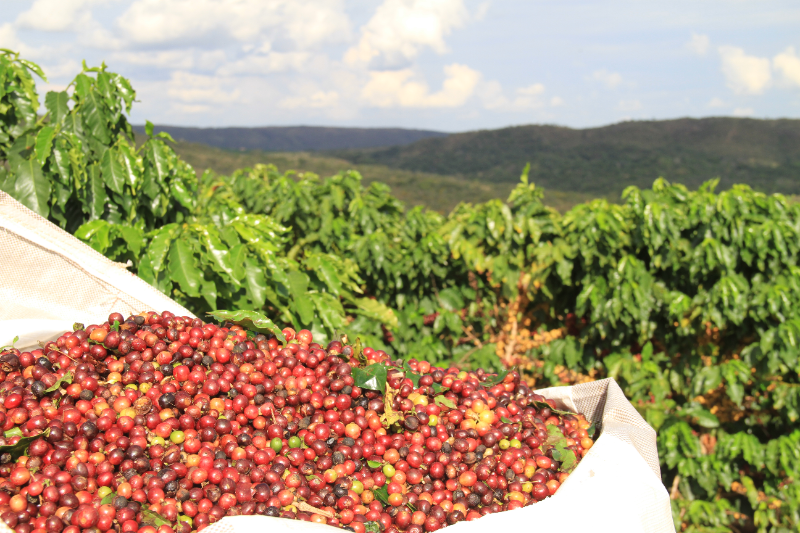Despite a 12.3% setback in November, coffee prices stabilised

Image credit: T&CTJ
The International Coffee Organization (ICO) Composite Indicator Price (I-CIP) decreased by 12.3% from October to November 2022, averaging 156.66 US cents/lb for the latter, whilst posting a median value of 156.83 US cents/lb. The I-CIP averaged 152.05 and 160.14 US cents/lb in July and August 2021, respectively. In November 2022, the I-CIP fluctuated in between 151.39 and 164.17 US cents/lb.
Average prices for all group indicators decreased in November 2022. The Colombian Milds and Other Milds, decreased by 14.8% and 10.9%, respectively, month on month in November. The former averaged 223.22 US cents/lb in November 2022, whilst the latter averaged 213.85 US cents/lb. The Brazilian Naturals fell by 13.4% to 166.54 US cents/lb. The Robustas fell below the 100 US cents/lb mark, averaging 92.59 US cents/lb for the month of November, a 10.1% decline from the previous month. The downturns are in part due to the average 2nd and 3rd positions of the ICE New York futures market, which lost 14.0% in November 2022 over October 2022. The average of the 2nd and 3rd positions of the ICE Futures Europe for the Robustas also shrank by 10.3%. The Colombian Milds-Other Milds differential suffered a month-on-month loss of 57.2%, closing in at 9.37 US cents/lb for November 2022.
The Colombian Milds-Brazilian Naturals and Colombian Milds-Robustas differentials declined by 18.7% and 17.8% to 56.68 and 130.63 US cents/lb in November 2022, respectively. Falling the least was the Other Milds Brazilian Naturals differential, declining by only 1.0%, to 47.31 US cents/lb. The Other Milds Robustas differential lost 11.5% from October to November 2022 reaching 121.26 US cents/lb. The Brazilian Naturals-Robusta differential retracted 17.2% to 73.95 US cents/lb for the aforementioned period.
The arbitrage between the New York and London Futures markets shrunk by 17.5%, falling to 82.13 US Cents/lb in November 2022 from 99.56 US cents/lb in October 2022 precipitated by the faster rate of price decline of Arabica compared with Robusta.
Intra-day volatility of the I-CIP increased 2.2 percentage points between October and November 2022, reaching 9.3%. Robustas and the London futures market were the least volatile amongst all group indicators, at 7.2% and 7.1%, respectively, in November 2022. The Brazilian Naturals’ volatility was the highest amongst the group indicators, averaging 11.9%, a 2.3 percentage point increase from the previous month. The variation in volatility of the Colombian Milds and Other Milds for October to November 2022 is 3.6 to 11.0% and 2.0 to 9.6%, respectively. The New York futures market remained the most volatile, posting an increase of 2.7 percentage points, averaging 12.5% for the month of November 2022.
The New York certified stocks increased by 45.3% from the previous month, closing in at 0.59 million bags, whilst certified stocks of Robusta coffee reached 1.45 million bags, representing a decrease of 4.6%.
Exports by Coffee Groups – Green Beans
Global exports of green beans in October 2022 totalled 8.5 million bags, compared with 8.72 million bags in the same month of the previous year, down 2.5%. The downturn was spread across most of the coffee groups, with the Brazilian Naturals alone starting the new coffee year on a positive footing with an uptick of 0.5%, the third consecutive months of positive growth, exporting 3.44 million bags of green beans.
The positive start to the new coffee year made by the Brazilian Naturals was driven by Brazil, the biggest producer and exporter of the Brazilian Naturals, with a 1.9% increase in the exports of green beans, outweighing the downturns of the other major origins of the Brazilian Naturals group – Ethiopia (-10.9%), Uganda (-6.0%) and Vietnam (-19.5%).
Exports of the Colombian Milds decreased by 4.1% to 0.94 million bags in October 2022 from 0.98 million bags in October 2021, driven by the contractions in Colombia and Tanzania whose exports of green beans were down 6.0% and 2.3%, respectively. Within this coffee group, Kenya alone started the new coffee year on a bright note, exporting an additional 46.2% of green beans in October 2022 as compared with October 2021. The decline in October 2022 is the fourth in a row for Colombia, and another month in which production is at fault for the decreasing exports – in October 2022 Colombia’s coffee output fell by 12%. The Colombian Coffee Growers Federation (FNC) attributed the decline in production to excess rains due to the La Niña event, which translated into excess water, less sunlight, and fewer blooms in coffee plantations.
Shipments of the Other Milds decreased by 4.3% in October 2022 to 1.3 million bags from 1.36 million bags in the same period last year. Guatemala (-28.0%), Honduras (-49.2%) and Peru (-8.4%) were behind this fall. In Honduras, the coffee industry continues to struggle with leaf rust, which is affecting production, while Guatemala’s output is being hampered due to climatic reasons and the availability of labour, all of which are having a knock-on effect on the countries’ exports.
Of the four coffee groups, the Robustas have recorded the worst performance in the new coffee year 2022/23, with exports falling by 4.8% to 2.82 million bags from 2.96 million bags. Except for India and Indonesia, all major origins within the Robustas group saw their exports of green beans fall in October 2022 – Uganda (-6.0%) and Vietnam (-19.5%). Uganda is still facing drought in most of its coffee-growing regions, which has led and is continuing to lead to lower outputs and, subsequently, lower exports.
Exports by Regions – All Forms of Coffee
In October 2022, South America’s exports of all forms of coffee decreased marginally by 0.2% to 4.99 million bags. The marginality of the growth rate was largely the result of increases in the exports of Brazil (1.1%) and Ecuador (48.3%), edged by the decreases in exports of Colombia (-2.3%) and Peru (-9.4%).
Exports of all forms of coffee from Asia and Oceania totalled 3.17 million bags in October 2022, 10,000 bags greater than in October 2021. The region’s miniscule growth rate, however, belies the strong growth rates amongst the major origins; India and Indonesia made gains of 15.1% to 0.54 million bags and 34.5% to 1.12 million bags, respectively, while Vietnam suffered a 19.5% fall to 1.37 million bags.
Exports of all forms of coffee from Africa decreased by 2.4% to 1.1 million bags in October 2022 from 1.13 million bags in October 2021. Ethiopia and Uganda were the two main origins behind the region’s downturn in exports in October 2022, with the respective growth rates of shipped coffee at -10.9% and -6.0%. The fact that Africa’s decrease of exports was softer than as suggested by the growth rates of the region’s top two biggest exporters is down to the counterweights of Burundi (316.7%), Côte d’Ivoire (83.2%) and Kenya (46.3%). However, the greater-than-normal growth rates of the three origins do not reflect fundamental changes to the respective domestic coffee industries but are technical anomalies due to large negative growth rates in October 2021. Burundi’s exports of all forms of coffee were down 66.5% and Côte d’Ivoire and Kenya by 79.1% and 54.1%, respectively.
In October 2022, exports of all forms of coffee from Mexico and Central America were down 14.6% to 0.49 million bags as compared with 0.57 million in October 2021. Of the 12 origins in the region only the Dominican Republic (10.5%), Mexico (1.1%) Nicaragua (24.6%) and Trinidad & Tobago (259.2%) saw exports increase in October 2022. Honduras exports fell by 49.2% in October 2022, with the volume of all forms of coffee shipped decreasing to 40,842 bags as compared with 80,328 bags. The origin continues to suffer from the impact of leaf-rust which affected the output of coffee year 2021/22 and is now having an adverse effect in the supply available for export. Of the region’s major origins (million bags and over), Costa Rica suffered the steepest fall, with its exports falling by 68.9% in October 2022 to 9,216 bags, as compared with 13,052 bags in the same period a year ago. The volume shipped in October 2022 is the lowest since September 1976, when 7,093 bags were exported. Costa Rica’s coffee institute, ICAFE, cites lower-than-expected production in coffee year 2021/22 as the reason for the drop in exports.
Exports of Coffee by Forms
Total exports of soluble coffee increased by 10.9% in October 2022 to 1.19 million bags from 1.07 million bags in October 2021. The share of soluble coffee in the total exports of all forms of coffee was 9.5% (measured on a moving 12-month average) in October 2022 as compared with 8.9% in October 2021. Brazil is the largest exporter of soluble coffee, and the country shipped 291,345 bags in October 2022, down 6.2% from 310,731 bags in October 2021. The second and third placed origins, India and Indonesia, however started the new coffee year at a gallop, with their soluble coffee exports up 25.0% and 33.7%, at 180,000 bags and 397,805 bags, respectively, in October 2022.
Exports of roasted beans decreased by 18.0% in October 2022 to 61,226 bags from 74,697 bags in October 2021.
Production and Consumption
The latest provisional outlook for total production in coffee year 2022/23 remains unchanged at 167.2 million bags, a 2.1% decrease as compared to 170.83 million bags in the previous coffee year.
World coffee consumption is projected to grow by 3.3% to 170.3 million 60-kg bags in 2022/23 as compared to 164.9 million for coffee year 2020/21. In 2022/23, consumption is expected to exceed production by 3.1 million bags.
For the full report, visit: ico.org.



